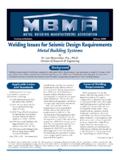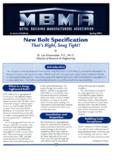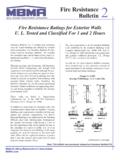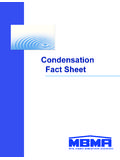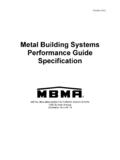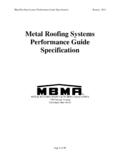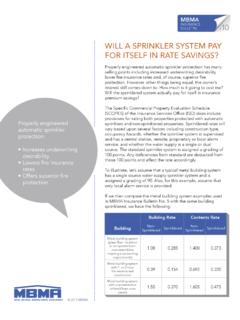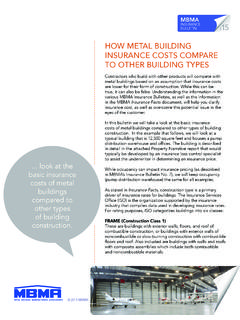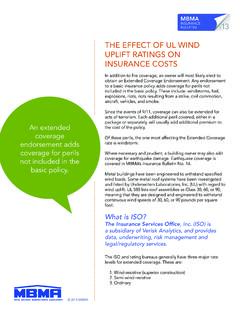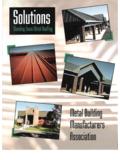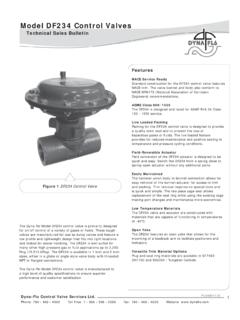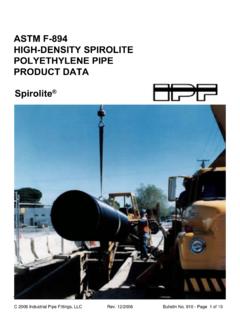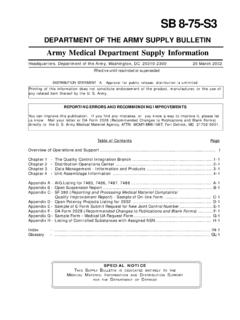Transcription of IBS Special Inspection Requirements - Approved Fabricators ...
1 1 | Page technical bulletin Spring 2012 METAL BUILDING SYSTEMS IBC Special Inspection Requirements - Approved Fabricators are Exempted! by W. Lee Shoemaker, , Director of Research and Engineering Introduction Special Inspection is defined in the International Building Code (IBC) as " Inspection of con-struction requiring the expertise of an Approved Special inspector in order to ensure the com-pliance with this code and the Approved construction documents." The focus of this Technic-al bulletin will be on compliance with the IBC code Requirements . Special Inspection re-quirements in the IBC have been evolving rapidly over the past few editions, so it is impor-tant to utilize the appropriate edition that is specified for any given project. However, this technical bulletin will focus on the Requirements in the 2012 IBC. As summarized in the Preface of the 2012 IBC, the "proper assembly of structural compo-nents, proper quality of materials used, and proper application of materials are essential to ensuring that a building, once constructed, complies with the minimum structural and fire-resistance Requirements of the code and the Approved design.
2 To determine this compliance often requires continuous or frequent Inspection and testing. Chapter 17 establishes these Special inspections and testing standards as well as reporting of the work to the building offi-cial." The Special Inspection Requirements of Chapter 17 are invoked by IBC Section Special Inspection of Fabricated Steel Except as noted below regarding Approved Fabricators , IBC Section requires the owner or the registered design professional in responsible charge to employ an Approved agency to perform inspections during con-struction for the types of work listed in Sec-tion 1705, which includes Section - Steel Construction, and Section - Special Inspections for Seismic Resistance of Structural Steel. With respect to the work performed by a steel fabricator, such as a metal building manufac-turer, Special inspections are not required if the fabricator is registered and Approved to perform such work without Special Inspection as defined by Section More on this is explained in the next section of this technical bulletin .
3 2 | Page IBC Section requires Special inspec-tion of structural load-bearing members and assemblies that are fabricated on the premis-es of a non- Approved fabricator's shop. For a non- Approved steel fabricator, the Special in-spection Requirements of Section for structural steel are to be in accordance with the quality assurance Requirements of AISC 360, Chapter N. Additional Special Inspection Requirements of Section , for structural steel fabri-cated on the premises of a non- Approved fa-bricator's shop, apply to the seismic force re-sisting systems in structures assigned to seismic design category (SDC) C, D, E, or F and are to be in accordance with the quality assurance Requirements of AISC 341. An ex-ception noted in Section applies to steel structures in SDC C that are not specifi-cally detailed for seismic resistance and are designed with a response modification factor, R, of 3 or less.
4 This is a common design op-tion for SDC C, and if elected, there would not be any Special Inspection Requirements invoked for both Approved and non- Approved Fabricators . It is important to note that the 2009 IBC did not exempt an Approved fabri-cator from these Special seismic inspections. For projects governed by earlier versions, the issue should be discussed with the building official. Approved Fabricator As previously noted, Special inspections nor-mally called for by Section 1705 are not re-quired where the work is done on the pre-mises of a fabricator registered and Approved to perform such work without Special inspec-tion (See IBC Section ). The ex-emption further explains that this approval shall be based upon review of the fabricator's written procedural and quality control ma-nuals and periodic auditing of fabrication practices by an Approved Special Inspection agency.
5 The steel fabrication industry has embraced the benefit of a strong quality control pro-gram with periodic auditing through programs such as AISC's Certification Program for Structural Steel Fabricators . Additionally, most metal building manufacturers have en-dorsed a quality control program with the In-ternational Accreditation Services (IAS) cus-tomized to the unique products and fabrica-tion methods of this industry. This accredita-tion program (IAS AC472) is a credible means for building officials to grant Approved fabri-cator status to metal building manufacturers. As noted in the IBC Chapter 2 definition of Approved fabricator, it is the building official who approves the qualified fabricator pur-suant to Chapter 17. Section of the 2012 IBC requires that "at completion of fabrication, the ap-proved fabricator shall submit a certificate of compliance to the building official stating that the work was performed in accordance with the Approved construction drawings.
6 " 3 | Page Structural Observations Additional Inspection Requirements for seismic and wind resistance in higher risk categories are indentified in the IBC as "structural ob-servations." This is defined in Chapter 2 of the IBC as "the visual observation of the structural system by a registered design pro-fessional for general conformance to the ap-proved construction documents." IBC Sec-tions and define the struc-tures that would require structural observa-tions for seismic resistance and wind resis-tance, respectively. When structural observa-tions are triggered by one of these provi-sions, Section requires the owner to hire a registered design professional to sub-mit to the building official a written statement identifying the frequency and extent of struc-tural observations. It is possible that steel fabrication could be included in these obser-vations and the metal building manufacturer would need to be made aware, by the regis-tered design professional, of any require-ments to accommodate the structural observ-er.
7 However, it is the observer who submits a report to the building official indicating that the site visits were made and identifying any unresolved deficiencies known to the struc-tural observer. AISC 360 Chapter N Special inspections are prescribed in Chapter 17 of the IBC, which invokes the quality as-surance Requirements of AISC 360 and AISC 341 for structural and seismic resistance, re-spectively. An Approved fabricator is exempt from the Special Inspection Requirements per Section , as previously discussed. However, it would be prudent to examine what the Special Inspection Requirements would be if the contract documents specifical-ly called for the structural steel to meet the quality assurance Requirements of AISC 360/341, thereby imposing more exacting ob-ligations than required by the IBC. AISC 360, Section N7, has a similar Inspection exemption for a steel fabricator Approved to perform work without third-party quality as-surance.
8 The commentary for this section goes on to state that this approval shall be based on review of the fabricator's written procedural and quality control manuals and periodic auditing of fabrication practices by an Approved Special Inspection agency. The AISC Certification Program for Structural Steel Fabricators is cited as an example. The IAS AC472 accreditation program for metal build-ing manufacturers exceeds the recommended criteria for an Approved Special Inspection agency. IAS AC472 requires two audits per year instead of the annual audit required by the AISC program. Further, IAS AC472 re-quires that a certified welding inspector be employed by the metal building manufactur-er. AISC 360 Section N7 states that the nonde-structive testing (NDT) Requirements of AISC 360 are not included in the quality assurance exemption granted an Approved fabricator.
9 It further states that the Approved fabricator may perform any required nondestructive tests when Approved by the authority having jurisdiction. AISC 341 is invoked by AISC 360 Section for the seismic force resisting system, which would cover the pertinent nondestructive tests of welds in the moment resisting frames of metal buildings. AISC 341, Section , requires ultrasonic testing (UT) on 100% of complete joint penetration (CJP) groove welds in material 5/16" and thicker. This is clearly more stringent than the Requirements of AISC 360, Section For example, in AISC 360, only 10% of the same CJP groove welds in Risk Category II structures require NDT. In AISC 341, Section , UT of a CJP groove weld is only required for demand critical welds in ordinary moment frames. The only demand critical welds in ordinary moment frames are the CJP groove welds of beam flanges to columns, as identified in AISC 341, Section The demand placed on the flange to end-plate weld of a web-tapered member has been shown to be low in recent full-scale shake table tests at UCSD that went beyond the maximum considered earthquake.
10 This is mostly due to the fact that for frames with web-tapered members, the flexural strength of the beam (rafter) will typically be reached first at some distance away from the connection, as noted in the AISC 341 Commentary, Section (b). Therefore, for ordinary moment frames used in metal building systems, there would be no demand critical CJP groove welds requiring NDT. 4 | Page SSummary Chapter 17 of the 2012 IBC defines Special inspections and structural observations that may be required for steel fabrication. Special inspections are not required for typical steel fabrication performed in the shop of an Approved fabricator; however, structural observations may be trig-gered for high wind and seismic applications in Sections and that could in-clude observations of steel fabrication if specifically included in the written plan of the registered design professional.
